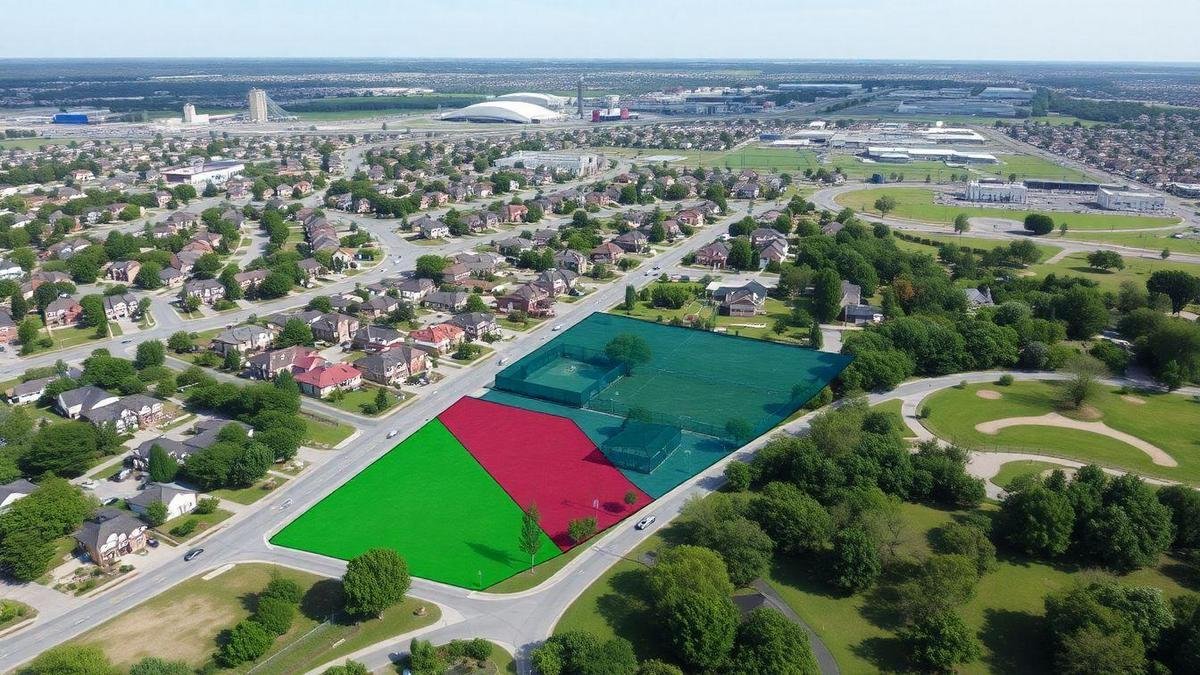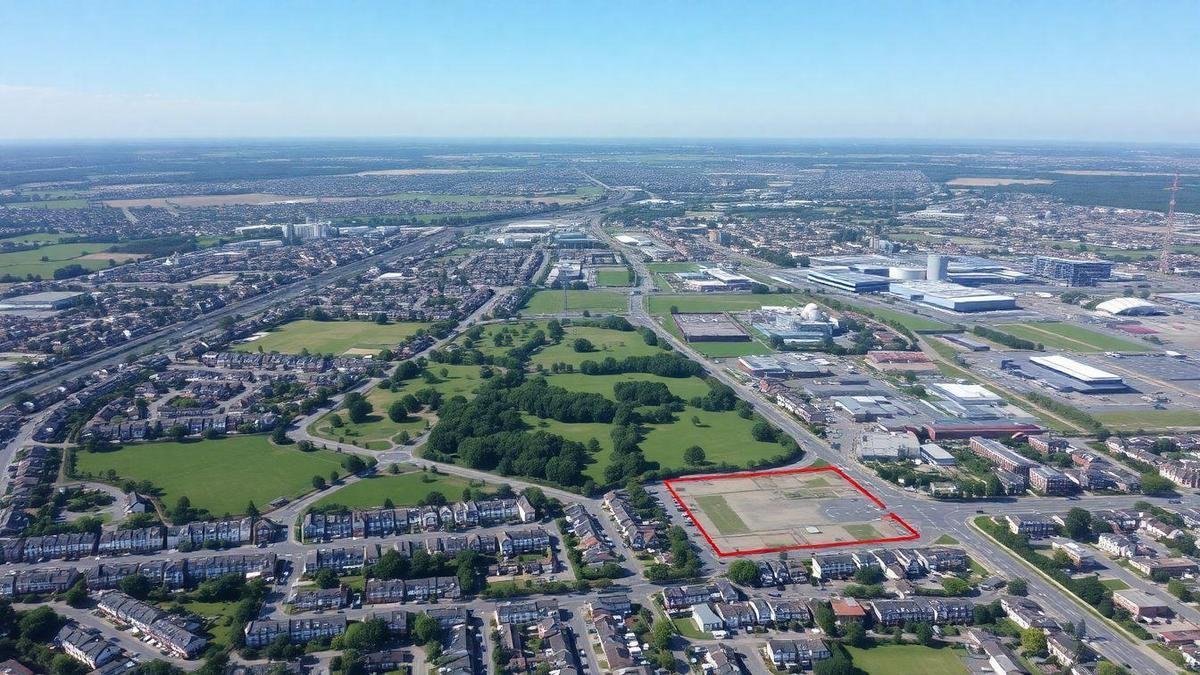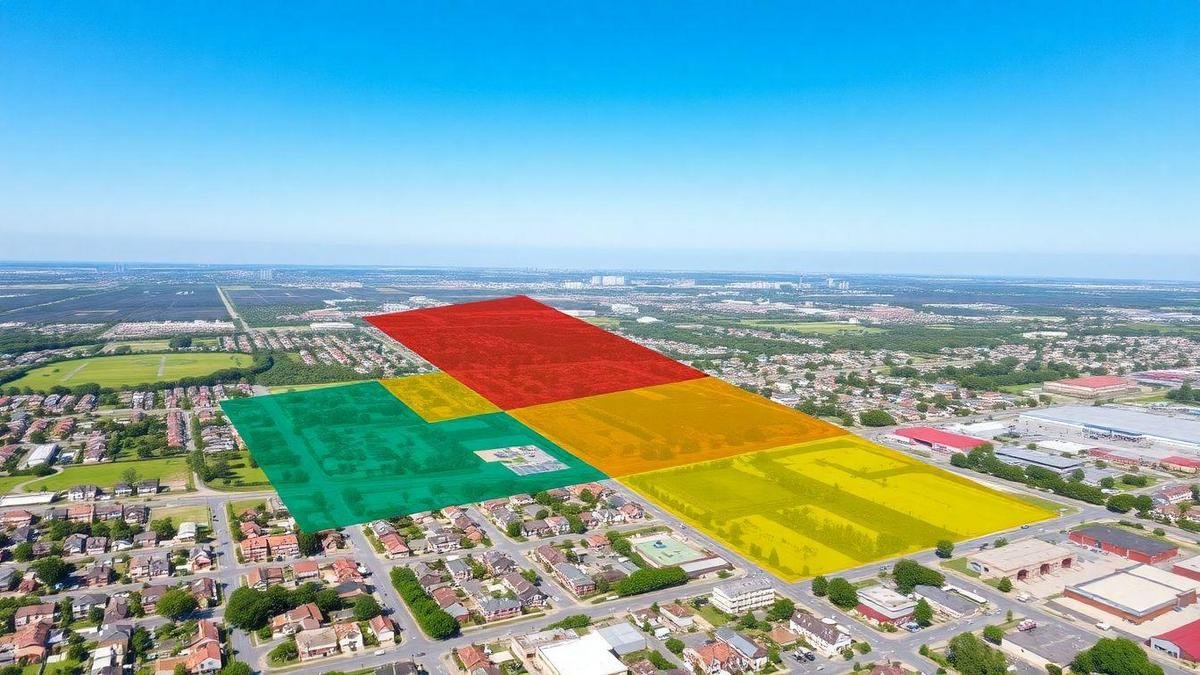Land zoning in the US for beginners can be a complex yet essential topic to grasp. This article will break down the basics of land zoning, its importance for property development, and the different zoning districts that exist. Readers will explore key terms, understand federal and state laws, and learn how zoning regulations impact property use. Moreover, it will provide insights into navigating the zoning permit process and how to read zoning maps effectively. By the end, beginners will feel more confident in their understanding of land zoning and its implications for real estate.
Essential Insights
- Land zoning decides how land can be used.
- Different zones allow different activities, like homes or businesses.
- Zoning protects community health and safety.
- Changes to zoning can be requested by property owners.
- Local governments enforce zoning rules.

Understanding Land Zoning Basics
What is Land Zoning?
Land zoning is a method used by local governments to control how land can be used. It divides land into different areas, or zones, each with specific rules. These rules dictate what activities can take place in each zone, like residential, commercial, or industrial uses. For example, a residential zone might allow homes but not factories. This helps maintain order in communities and ensures that land is used effectively.
Importance of Land Zoning in Development
Understanding land zoning is crucial for anyone involved in land development. It affects property values, investment opportunities, and the overall planning of a community. Here are some key reasons why land zoning matters:
- Protects Property Values: Zoning helps keep incompatible uses apart, which can protect homeowners from noise or pollution.
- Guides Development: It provides a clear framework for developers to follow, reducing the risk of costly mistakes.
- Promotes Sustainable Growth: Zoning encourages thoughtful planning, which can lead to more sustainable communities.
Key Terms in Land Zoning
When diving into land zoning in the US for beginners, it’s helpful to know some essential terms:
| Term | Definition |
|---|---|
| Zoning Ordinance | A law that outlines the zoning regulations for a specific area. |
| Use Variance | A special permission to use land in a way that differs from the zoning rules. |
| Zoning Map | A visual representation showing the different zones within a municipality. |
| Setback | The required distance between a building and the property line. |
These terms form the backbone of understanding how zoning works and how it impacts land development.

Overview of US Zoning Regulations
Federal vs. State Zoning Laws
In the United States, zoning laws are not uniform. They vary significantly between federal and state levels. The federal government provides a broad framework, but it is primarily the states that set specific zoning regulations. Federal laws may establish guidelines, especially concerning land use that affects the environment or public safety. However, states have the power to tailor these laws to fit their unique needs and circumstances.
Local Zoning Authority and Its Role
At the local level, zoning authority plays a crucial role. Local governments, such as cities or counties, create zoning ordinances that dictate how land can be used. This can include regulations on residential, commercial, or industrial development. Local zoning laws are often detailed and can vary widely even within the same state.
The local zoning authority is responsible for:
- Issuing permits for land development.
- Conducting public hearings to gather community input.
- Enforcing zoning regulations to maintain order and safety.
How Regulations Impact Property Use
Zoning regulations can significantly shape property use. They determine what can be built, where it can be built, and how properties can be utilized. For instance, residential zoning may restrict buildings to homes, while commercial zoning allows businesses.
Here’s a simple table to illustrate the impact of zoning regulations:
| Zoning Type | Allowed Uses | Example |
|---|---|---|
| Residential | Homes, apartments | Single-family homes |
| Commercial | Retail, offices, restaurants | Shopping centers |
| Industrial | Factories, warehouses | Manufacturing plants |
| Agricultural | Farms, greenhouses | Crop production |
Understanding these regulations is essential for anyone interested in land zoning in the US for beginners. They not only affect property values but also influence community development and quality of life.

Zoning Districts Explained
Types of Zoning Districts
Zoning districts are like the rules of a game for land use. They tell property owners what they can and cannot do with their land. Here are the main types of zoning districts:
| Zoning Type | Description |
|---|---|
| Residential | Areas where people live, like houses and apartments. |
| Commercial | Places for businesses, such as shops and offices. |
| Industrial | Zones for factories and warehouses. |
| Agricultural | Land used for farming and growing crops. |
| Mixed-Use | Combines residential and commercial uses in one area. |
Each type has its own rules. For instance, a residential zone may not allow a factory to be built next to homes. This keeps neighborhoods peaceful and safe.
How Districts Affect Property Value
Zoning districts can greatly influence property value. A home in a residential area may be worth more than the same home in an industrial zone. Here’s why:
- Demand: Residential areas often have higher demand. People prefer living in quiet neighborhoods.
- Restrictions: If a property is in a commercial zone, it may have more restrictions. This can lower its value.
- Future Development: If a district is changing, like turning from industrial to residential, property values may rise.
Investors must watch these trends. Understanding zoning can help them make better decisions.
Navigating Zoning Districts for Beginners
For those new to land zoning in the US, here are some tips:
- Research Local Laws: Each city or county has its own zoning rules. Check local government websites for information.
- Visit the Area: Seeing the land can provide insights that maps cannot.
- Speak with Experts: Real estate agents or zoning attorneys can offer valuable advice.
- Attend Community Meetings: Local meetings can reveal future plans that might affect property values.
By following these steps, beginners can better understand zoning districts and make informed choices.

Zoning Laws for Beginners
Common Zoning Laws to Know
Zoning laws are rules that dictate how land can be used. They are crucial for land zoning in the US for beginners. Here are some common types of zoning laws:
| Zoning Type | Description |
|---|---|
| Residential | Areas designated for homes and apartments. |
| Commercial | Zones for businesses like shops and offices. |
| Industrial | Areas meant for factories and warehouses. |
| Agricultural | Land used for farming and livestock. |
| Mixed-Use | Combines residential, commercial, and sometimes industrial uses. |
Understanding these categories helps investors know what can be built where. For instance, a residential zone won’t allow a factory to pop up next door, which protects home values and community character.
Zoning Violations and Consequences
Zoning violations occur when property owners do not follow the established zoning laws. This can lead to serious consequences. Some common violations include:
- Building a structure that does not comply with zoning regulations.
- Using a property for a purpose not allowed by its zoning classification.
- Failing to obtain necessary permits before construction.
The consequences of such violations can be severe. They may result in fines, mandatory removal of structures, or even legal action. For example, a homeowner who builds a fence too tall may be ordered to take it down, which can be both costly and frustrating.
Resources for Understanding Zoning Laws
For those new to zoning laws, various resources can help clarify these complex rules. Here are some valuable options:
- Local Government Websites: Most city or county websites provide zoning maps and regulations.
- Planning Departments: These departments often have staff available to answer questions.
- Real Estate Professionals: Agents and brokers can offer insights into local zoning laws.
- Online Courses: Websites like Coursera or Udemy offer courses on real estate and zoning.
These resources can help investors navigate the zoning landscape effectively, ensuring they make informed decisions.

Types of Zoning in the US
Residential Zoning Explained
Residential zoning is a vital aspect of land use planning in the United States. It defines areas where people can live and sets rules for building homes. These rules can dictate the type of houses that can be built, their height, and how close they can be to each other.
For instance, in a single-family residential zone, only one house is allowed per lot. This type of zoning is common in suburban areas. On the other hand, multi-family residential zones allow for apartments or townhouses, making them ideal for urban settings where space is limited.
The purpose of residential zoning is to create safe, comfortable living environments. By controlling how land is used, cities can maintain a sense of community and protect property values.
Commercial Zoning Explained
Commercial zoning pertains to areas designated for business activities. This zoning type allows for the establishment of shops, offices, and other commercial enterprises. Each commercial zone has specific rules about what types of businesses can operate there, which helps to minimize conflicts between different land uses.
For example, a retail commercial zone may permit stores and restaurants but might restrict industrial activities. Conversely, an industrial commercial zone allows for factories and warehouses, which would not be suitable near residential neighborhoods.
Commercial zoning is essential for economic growth. It supports local businesses and provides jobs, ultimately contributing to the community’s overall prosperity.

The Role of Land Use Planning
What is Land Use Planning?
Land use planning is a strategic approach to managing land resources. It involves analyzing how land is used and making decisions about its future. This process helps to create a plan that balances various needs, such as housing, business, and nature. By mapping out how land can be used, planners aim to create a sustainable environment that benefits everyone.
Benefits of Effective Land Use Planning
Effective land use planning brings numerous advantages. Here are some key benefits:
- Improved Quality of Life: Well-planned areas have better access to parks, schools, and services.
- Economic Growth: Proper land use can attract businesses, leading to job creation.
- Environmental Protection: Careful planning helps to protect natural resources and reduce pollution.
- Community Cohesion: Thoughtful designs foster a sense of community and belonging.
| Benefit | Description |
|---|---|
| Improved Quality of Life | Access to essential services and green spaces |
| Economic Growth | Increased job opportunities and business development |
| Environmental Protection | Safeguarding natural resources |
| Community Cohesion | Building strong neighborhood ties |
How Planning Affects Zoning Decisions
Planning plays a critical role in zoning decisions. Zoning refers to the laws that dictate how land can be used. When planners create a land use plan, they consider various factors, such as population growth and infrastructure needs. This information helps them make informed zoning choices.
For example, if a city is growing, planners might zone areas for new homes and businesses. This can lead to a thriving community that meets the needs of its residents. Conversely, poor planning can lead to overcrowding and inadequate services.
In summary, effective land use planning is essential for creating balanced and thriving communities. It shapes zoning decisions that impact the daily lives of residents and the future of the area.

Zoning Map Interpretation
Reading a Zoning Map
A zoning map is a crucial tool for anyone involved in land development. It shows the different zones in a specific area and what each zone allows. For example, some zones may be for residential use, while others are for commercial or industrial purposes. By reading a zoning map, one can quickly understand how land can be used and what restrictions may apply.
Identifying Zoning Classifications
Zoning classifications help to organize land use. Here are some common classifications found on zoning maps:
| Zoning Classification | Description |
|---|---|
| Residential | Areas designated for homes. |
| Commercial | Areas for businesses and shops. |
| Industrial | Zones for factories and warehouses. |
| Agricultural | Land for farming and crops. |
| Mixed-Use | Areas that can have both residential and commercial uses. |
Each classification comes with its own set of rules. For instance, residential zones may limit the height of buildings, while commercial zones might allow for larger structures. Understanding these classifications is key for those looking to invest in land.
Tips for Beginners on Zoning Maps
For those new to land zoning in the US for beginners, here are some helpful tips:
- Start with the Legend: The legend explains what each color and symbol means. This is the first step to understanding the map.
- Look for Boundaries: Pay attention to the lines that separate different zones. These boundaries can affect property values and potential uses.
- Check Local Regulations: Zoning laws can vary by city or county. Always check with local authorities for the most accurate information.
- Use Online Resources: Many local governments provide online maps that can be zoomed in for better detail.
Understanding zoning maps may seem tricky at first, but with practice, it becomes easier. They are essential for making informed decisions in land development.

Residential vs. Commercial Zoning
Differences Between Residential and Commercial Zoning
When it comes to land zoning in the US for beginners, understanding the differences between residential and commercial zoning is crucial. Residential zoning is primarily for homes and living spaces. It allows for single-family houses, apartments, and townhouses. On the other hand, commercial zoning is meant for businesses. This includes shops, offices, and factories.
| Aspect | Residential Zoning | Commercial Zoning |
|---|---|---|
| Purpose | Housing | Business activities |
| Building Types | Homes, apartments | Shops, offices, warehouses |
| Traffic | Lower volume | Higher volume |
| Hours of Operation | Generally quiet hours | Open during business hours |
Impact on Property Development
The type of zoning affects how a property can be developed. For instance, a residential area may have restrictions on noise and traffic to keep the environment peaceful. In contrast, commercial zones may allow for high traffic and longer operating hours. This difference can greatly impact property values and potential returns on investment.
Choosing the Right Zoning for Investment
Selecting the right zoning is essential for investors. They must consider their goals and the type of development they envision. For example, if an investor is looking to build a shopping center, they should focus on commercial zoning. Conversely, if the aim is to create a housing community, residential zoning is the way to go.
Investors should also keep in mind local regulations and community needs. Understanding these factors can lead to better investment decisions and successful projects.

The Zoning Permit Process
Steps to Obtain a Zoning Permit
The zoning permit process can be broken down into several clear steps. For anyone involved in land development, understanding these steps is crucial. Here’s a simplified breakdown:
- Research Local Zoning Laws: Every area has its own rules regarding land use. It’s important to know what can and cannot be done on the land.
- Prepare Application: Gather all necessary documents. This often includes property descriptions, maps, and plans for development.
- Submit Application: Turn in the application to the local zoning office. Make sure to include all required documents to avoid delays.
- Public Hearing: In many cases, a public hearing is held. This is where community members can voice their opinions on the proposed project.
- Decision: After the hearing, the zoning board will make a decision. They may approve, deny, or request changes to the application.
- Receive Permit: If approved, the zoning permit will be issued. This allows the developer to move forward with their plans.
Common Challenges in the Permit Process
Navigating the zoning permit process can come with its share of challenges. Here are some common obstacles developers may face:
- Community Opposition: Local residents may not support the development, leading to pushback during public hearings.
- Incomplete Applications: Missing documents can cause delays. It’s essential to double-check all submissions.
- Changing Regulations: Zoning laws can change, impacting the permit process. Staying updated is key.
- Time Delays: The process can take longer than expected, which may affect project timelines.
| Challenge | Description |
|---|---|
| Community Opposition | Local residents may express concerns or objections. |
| Incomplete Applications | Missing or incorrect documents can lead to rejections. |
| Changing Regulations | New laws can alter project plans unexpectedly. |
| Time Delays | The process can be slower than anticipated. |
Tips for a Successful Zoning Permit Application
To increase the chances of a successful zoning permit application, developers can follow these tips:
- Engage with the Community: Before submitting an application, meet with local residents to discuss the project. This can help build support.
- Consult Professionals: Working with a land use attorney or a zoning consultant can provide valuable insights.
- Be Thorough: Ensure that all documents are complete and accurate. Attention to detail can make a big difference.
- Prepare for the Hearing: Practice presenting the project clearly and confidently. Anticipate questions and concerns from the audience.
In the End…
Land zoning in the US for beginners is a fundamental aspect of property development that can significantly influence how land is utilized and what can be built. By understanding the importance of zoning, the various zoning districts, and the processes involved, individuals can navigate the complexities of real estate with confidence. Knowledge of key terms, local regulations, and the zoning permit process equips newcomers with the tools they need to make informed decisions.
As they embark on this journey, it is essential to remember that zoning is not just a set of rules; it is a framework that shapes communities and protects property values. With this newfound understanding, readers are encouraged to delve deeper into the world of land development and explore more insightful articles at Land Development Hub. For those considering investment opportunities, it might be worthwhile to explore the growing potential for foreigners investing in US real estate or check out the best states for land development.
Eduardo Bugallo, PhD.

5 Responses
[…] Check local zoning laws. […]
[…] Zoning Compliance: They ensure that the land use meets local zoning laws, which are essential for understanding land zoning. […]
[…] steps and requirements, making the development process more efficient. Familiarizing oneself with local zoning regulations is also essential for effective […]
[…] local regulations. Having this information upfront helps avoid costly mistakes later. Understanding zoning laws is essential for making informed […]
[…] understood, it could lead to costly redesigns or even project cancellations. Understanding local zoning laws is essential to avoid such […]